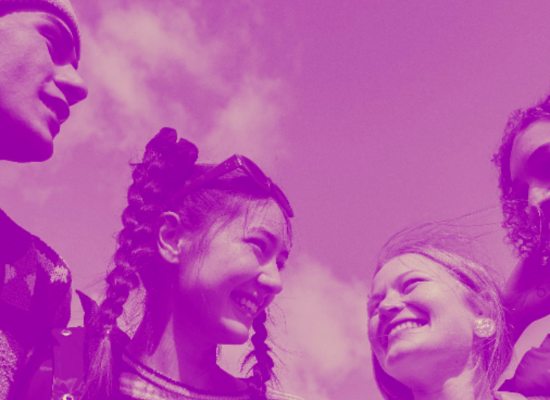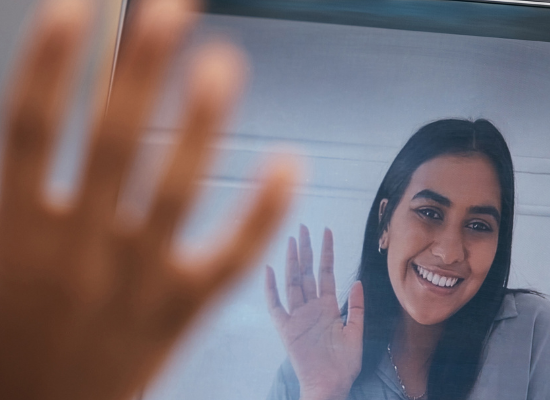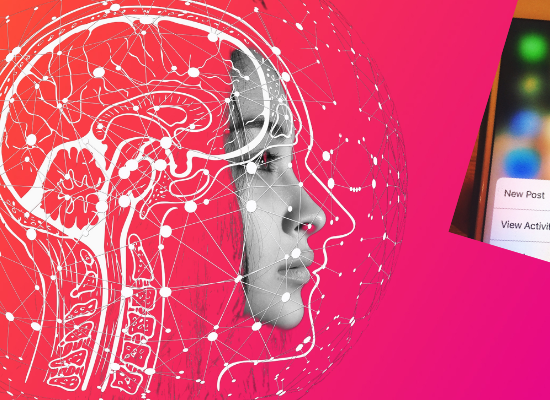
Stephanie Hepburn is a writer in New Orleans. She is the editor in chief of #CrisisTalk. You can reach her at .
In the summer of 2022, we were supposedly in post-pandemic normalcy. Sure, the pandemic itself wouldn’t be deemed officially over by the United States federal government until May 11, 2023, but many of us had already slid back into day-to-day, in-person living. My family and I were in Los Angeles, doing some of the travel we’d held off on since the disaster hit the U.S. in March 2020. When it came to masks, we couldn’t get on the same page. Some of us had a “when in Rome” philosophy (if they do, we do), while others thought the virus didn’t much care about anyone’s philosophy, so it was better just to wear one.
I’d been chatting with Dr. Howard Goldman about writing a second paper for the Think Bigger Do Good series, which is supported by the Thomas Scattergood Foundation, Peg’s Foundation, Patrick P. Lee Foundation and Peter and Elizabeth Tower Foundation. The previous year, former New York State Mental Health Commissioner Dr. Michael Hogan and I wrote on how communities must use 988 to improve care and rectify crisis system disparities. As I walked the Venice Canals that summer, tracking the daily rise and dip of the water (some days there was nearly none), my mind firmly landed on kids and how the pandemic interrupted their childhoods. By then, most were back in the classroom — even though hybrid was a thing in many communities until summer 2021. I wondered if the return to school ended up being the solution we all — parents and mental health experts — thought it would be. And if not, why not?
The word from experts is that, even before the pandemic, kids were not OK, but the public health emergency made things worse. In 2021, Dr. Vivek Murthy, U.S. Surgeon General, issued an advisory on protecting youth mental health. (He also recently issued an advisory on social media and youth mental health. I nearly clapped when I read it.) The same year, the American Academy of Pediatrics, American Academy of Child and Adolescent Psychiatry and Children’s Hospital Association declared a national emergency in child and adolescent mental health.
Nearly every mental health and substance use disorder conference and call I’ve participated in echoed these sentiments — kids weren’t doing well. But what did that mean, exactly?
Launching #CrisisTalk, thanks to my boss, David Covington, has given me a phenomenal opportunity to speak with leaders throughout the U.S. It has also given me access, through the openness and kindness of the people I’ve interviewed, to data. Thanks to them, and their tireless care and advocacy, I was well-situated to dig into my questions and those of the many caretakers, friends and family who’ve witnessed the challenges their young loved ones are facing.
The paper What About the Kids? Child and Adolescent Crises, the Pandemic, and 988 pulls in data from the CDC, the McKinsey Health Institute, YouthLine at Lines for Life, the Trevor Project, 988 Lifeline, the Institute of Education Sciences’ National Center for Educational Statistics and other youth-focused organizations.
To understand where kids are today, we first need to unpack the youth Covid experience, which wasn’t uniform. Those already marginalized became more so and while children and adolescents are frequently smushed together as an age demographic marked by rapid growth and development, a five-year-old is developmentally quite different from a fifteen-year-old. Also, since March 2020, when then-President Trump declared a national emergency, the nation ebbed in and out of viral surges and state and local leaders responded differently — so some young people navigated virtual and hybrid learning for nearly two years, while others were back in the classroom by April 2020. Furthermore, just because the government declares a pandemic over doesn’t mean the echoing effects are.
It’s not surprising that people felt lonely in the uncertain and disconnected world of Covid lockdown. Nor is it a shock that those especially affected were adolescents, years defined by individualization and a high need for peer connection. When I interviewed Emily Moser, director of YouthLine, a peer-to-peer support helpline at Lines for Life in Oregon, she told me the pandemic kicked the challenges of navigating early adolescence into high gear. The number of adolescents 11 to 14 contacting the line grew and youth overall increasingly reported loneliness.
Reina Chiang was 15 when Covid hit. She told me she’d felt alone for months even before the pandemic and by Spring 2020 — when Maryland was on lockdown — she said there was “nothing to do but sit at home and think.”
When writing the paper, I followed up with Moser to get an update — had loneliness lessened with the return to school? The answer was no. In fact, she and her team shared that loneliness reported by young people (ages 11 to 24) contacting the peer line increased slightly from 12 percent in March 2020-January 2021 to 14-15 percent in July 2021-June 2022. The percentage of youth reporting mental health concerns also rose, doubling from 17 percent in the first year of the pandemic to 35 percent by July 2021, where it still hovered in June 2022.
To measure the pandemic’s impact on behavioral health service use, Kana Enomoto, Reina’s mom and the director of Brain Health at the McKinsey Health Institute and former acting administrator at the Substance Abuse and Mental Health Services Administration, and Kevin Collins, data lead for McKinsey Health Institute, analyzed claims data for 250,000 providers who delivered behavioral health care to more than 35 million Americans in 2019, 2020, 2021 and 2022 — including those enrolled in commercial, Medicaid and Medicare plans.
The data paints a stark picture. The pandemic and physical distancing requirements resulted in a plummet in behavioral health service use for all ages. As the disaster ticked on, service use rebounded least for children and adolescents ages 0 to 18. In May 2021, Collins told me that during Covid, there were fewer opportunities to identify children’s needs when they were away from in-person school and corresponding support networks.
Schools are a primary referral source for youth to mental health services. However, school disruption has been rampant. Teacher friends in New Orleans and North Carolina have shared with me that the return to school was, well, bumpy. There was no handbook for how to navigate a return to the classroom, leaving staff scratching their heads on school procedures and protocols — why is kid X not considered a close contact but kid Y is? Why did the school, which knew kid Z had Covid, not send out the close contact email for days, leaving exposed students and their families unaware as those students continued to attend school?
Teachers have told me that teaching over the past three years has been akin to Whac-A-Mole — address one problem and suddenly there’s another, whether Covid shutdowns, quarantining teachers and students or having to navigate teaching in-class and virtual students simultaneously. Ask teachers about the past few years and many will shudder.
School administrators and teachers have shared that their students seemed to face more challenges and appeared younger, less mature than in years past. They aren’t alone in their observations. During the 2021-2022 school year, more than 80 percent of public schools participating in the School Pulse Panel survey by the Institute of Education Sciences’ National Center for Educational Statistics reported that the pandemic harmed socio-emotional and behavioral development.
The School Pulse Panel survey data revealed chronic student and teacher absenteeism and a nationwide substitute teacher shortage, resulting in teachers on their prep period, administrators and non-teaching staff having to cover classes. The virus itself also continues to wreak havoc — even as recently as December, 36 percent of participating public schools reported having students in quarantine.
School avoidance is also increasingly an issue. In November, Andrea Rifkind, program director at Sheppard Pratt Health System’s Care and Connection for Families, an in-home crisis stabilization program in Montgomery County, Maryland, told me the program is getting more referrals for youth avoiding school because of their mental health needs. The program provides short-term, whole-family crisis intervention and counseling services for young people ages 5 to 18. For most of the pandemic, the average client age was 13 to 14 years old; however, it has dropped to 12 in the 2023 fiscal year.
Care and Connection for Families has also begun receiving school referrals for elementary school students expressing suicidal ideation. The majority of their clients are Hispanic or Black. Data from the Trevor Project, the CDC, the McKinsey Health Institute and studies published during the pandemic further highlight disparities, including sexual victimization, suicide attempt, psychiatric boarding and behavioral health service use, with LGBTQ, American Indian or Alaska Native, Black, female and multiracial youth often most marginalized.
My hope with What About the Kids? Child and Adolescent Crises, the Pandemic, and 988 is to highlight the disparities and the problem with thrusting youth into systems created for adults and shed light on what does help like mobile crisis services, in-home crisis stabilization, primary care-child psychiatry access programs, school-mental health partnerships, 911-988 diversion and peer-to-peer services, including those for children and adolescents but also their families.
Thanks to 988, we have an opportunity to decriminalize youth mental health, build interconnected youth-based crisis services and provide individualized care to allow children and adolescents to participate in their day-to-day lives and have continued access to education, peers and other school-based supports, helping them remain engaged and build resiliency.
You can read the full Think Bigger Do Good paper here: https://thinkbiggerdogood.org/what-about-the-kids-child-and-adolescent-crises-the-pandemic-and-988.










